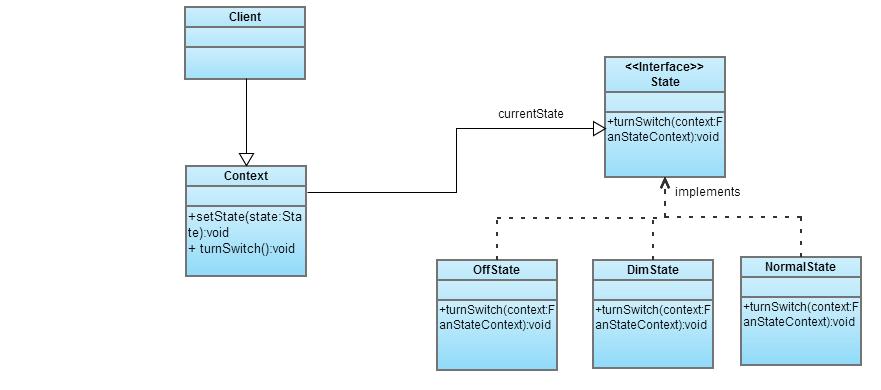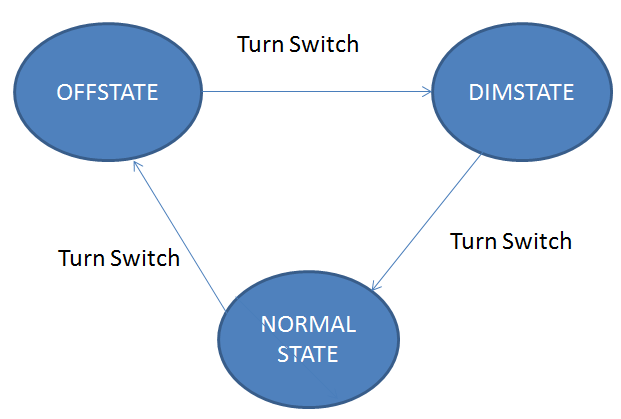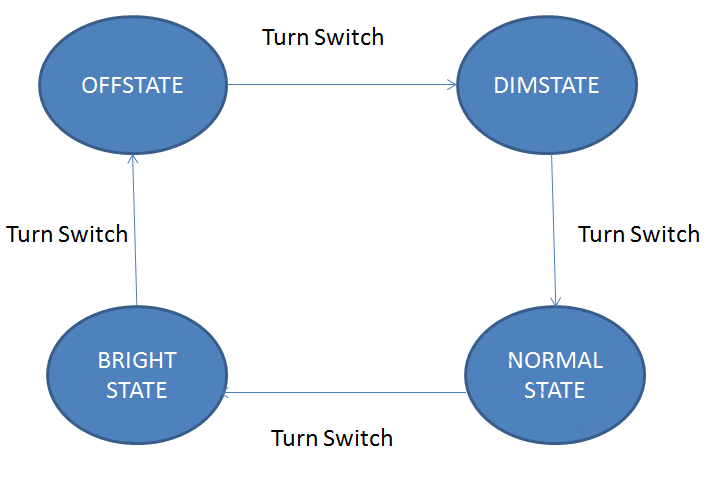CSC/ECE 517 Fall 2012/ch2a 2w21 ap: Difference between revisions
| Line 70: | Line 70: | ||
Finite state machine for this logic: | Finite state machine for this logic: | ||
[[File:fsm.png|thumb|Finite State Machine]] | |||
=A Java implementation using the state pattern= | =A Java implementation using the state pattern= | ||
Revision as of 00:03, 27 October 2012
Design patterns are convenient ways of reusing object-oriented code between projects and between programmers. The idea behind design patterns is to write down and catalog common interactions between objects that programmers have frequently found useful. The design patterns are divided into creational, structural and behavioral.
Behavioral Patterns
Behavioral patterns help you to define the communication between objects in your system and also specify how the flow is controlled in a complex program. These patterns are concerned with interactions between the objects. The interactions between the objects should be such that they are talking to each other and still are loosely coupled. This helps in avoiding dependencies and hard-coding.
State Pattern
State pattern is a behavioral software design pattern where behavior of any object depends upon current state of the object. A monolithic object's behavior is a function of its state, and it must change its behavior at run-time depending on that state. If an object has multiple states and corresponding behaviors, the class becomes too complex with numerous conditional statements if all the transitions are included as the functions of the same class. Also, it becomes difficult to incorporate more states in the same structure.
Therefore, to make the code more clean and modular, only state is included as a property of the object and behavior for each transition is encapsulated in the separate class. When an object's internal state changes, its behavior is changed dynamically. Object appears to change its class.
Static conditional statements are replaced by a finite state machine which decides the transition flow of the object.
Class Diagram

There is a Context class which communicates with the outside world. This class maintains the state of the corresponding object. It can have a number of internal states. The Context class is also called as Wrapper class. An interface State defines a common interface for all the concreate states. The states all implement the same interface; thus they are interchangeable. Our code can be in one of these states at a time. The individual states in our example are OffState, DimState and NormalState.
State transition logic can be defined either in the wrapper class or in each individual state subclass. If it is included in wrapper class, structure becomes static, i.e., we can’t dynamically add new states to the structure. On the other hand, if it is included in each individual class, coupling increases.
Finite State Machine
There are two approaches which are commonly used:
- Table based approach:This approach lists all the transitions as a function of the current state and input message. This approach works well when finite state machine is not too complex.
- Pattern based approach:In this approach, a conditional logic is used for transitions.
A Real Life Example
Scenario
Consider an example of a bulb which works in three modes. Off, dim and normal. Initially, the bulb is in off state. When we turn the switch, it glows and goes into dim state. If we turn the switch again, it goes into normal state. It again goes into off state on turning the switch.
A Possible Java Implementation
package patterns;
class LightStateContext {
private int currentState;
public LightStateContext() {
currentState = 0;
}
public void turnSwitch(){
if (currentState == 0){
currentState = 1;
System.out.println("change to dim state.");
} else if (currentState == 1){
currentState = 2;
System.out.println("change to normal state.");
} else if (currentState == 2){
currentState = 0;
System.out.println("change to off state.");
}
}
}
public class InefficientCodeDemo{
public static void main(String[] args) {
LightStateContext context = new LightStateContext();
while (true) {
context.turnSwitch();
}
}
}
The class turnSwitch acts as finite state machine for this scenario. It contains the conditional logic for state transitions. Lots of 'if else' statements make the code unnecessarily complex. Also, to add another state for the bulb, we need to change the original lightStateContext class which makes this code inefficient and unavailable for extension.
A Better Solution
A better solution can be provided using state pattern. We can clearly identify 3 states of the bulb, off, dim and normal. We can also formulate the logic for finite state machine.
- If light is in off state and we turn the switch, resulting state is dim.
- If light is in dim state and we turn the switch, resulting state is normal.
- If light is in normal state and we turn the switch, resulting state is off.
Finite state machine for this logic:

A Java implementation using the state pattern
We go about implementing the state pattern in the following way:
- Identify the states and define values for each state (typically constants)
- Create an instance variable that holds the current state.
- Identify all the actions that can occur in the system and find out all the actions that can cause state transition.
- Create a class that acts as the state machine.
- For each action, create a method that uses conditional statements to determine what behavior is appropriate in each state. You can also transition to another state in the conditional statement.
Let us see an example that shows an efficient implementation using the state pattern.
package patterns;
class LightStateContext {
private State currentState;
public LightStateContext() {
currentState = new OffState();
}
public State getCurrentState() {
return currentState;
}
public void setCurrentState(State currentState) {
this.currentState = currentState;
}
public void turnSwitch(){
currentState.turnSwitch(this);
}
}
interface State{
void turnSwitch(LightStateContext context);
}
class OffState implements State{
@override
public void turnSwitch(LightStateContext context) {
context.setCurrentState(new DimState());
System.out.println("change to dim state.");
}
}
class DimState implements State{
@Override
public void turnSwitch(LightStateContext context) {
context.setCurrentState(new NormalState());
System.out.println("change to normal state.");
}
}
class NormalState implements State{
@Override
public void turnSwitch(LightStateContext context) {
context.setCurrentState(new OffState());
System.out.println("change to off state.");
}
}
public class StatePatternDemo {
public static void main(String[] args) {
LightStateContext context = new LightStateContext();
while (true)
context.turnSwitch();
}
}
Advantages
Advantages of the state pattern can be summarized as:
- One object for one state.
- By using objects we can make the states explicit and reduce the effort needed to understand and maintain the code.
- If the state pattern is implemented correctly, the code becomes easy to extend.

Let us assume we are asked to show that when the bulb is in the normal state and we turn the switch the bulb glows bright. To incorporate this kind of change we will need to:
- Add a new BrightState that implements the State interface
- In the previous state turnSwitch set the current state to BrightState
context.setCurrentState(new BrightState());
class BrightState implements State{ @Override public void turnSwitch(FanStateContext context) { context.setCurrentState(new OffState()); System.out.println("change to off state."); } }
Limitations
- Too many objects are created. This is a price that we need to pay for better flexibility and maintainability.
- Becomes too heavy when Finite State Machine is not that complex.
State Pattern Vs Strategy Pattern
Strategy pattern is another behavioral software design pattern which separates the behavioral algorithms from the object. Each algorithm is encapsulated in a different class. Depending upon the properties of the current object, decision of invoking an algorithm is taken at runtime.
- Main difference between the state pattern and strategy pattern is in strategy pattern, once a decision is made to invoke a particular algorithm, it is not possible to change it. Whereas in state pattern, transition between states occurs at runtime.
- In state pattern, decision of which state to invoke depends only on one variable.
- We can say that state pattern is a type of strategy pattern where each state represents a difference behavioral algorithm for the object in context.
Conclusion
References
http://www.allapplabs.com/java_design_patterns/behavioral_patterns.htm
http://sourcemaking.com/design_patterns/state